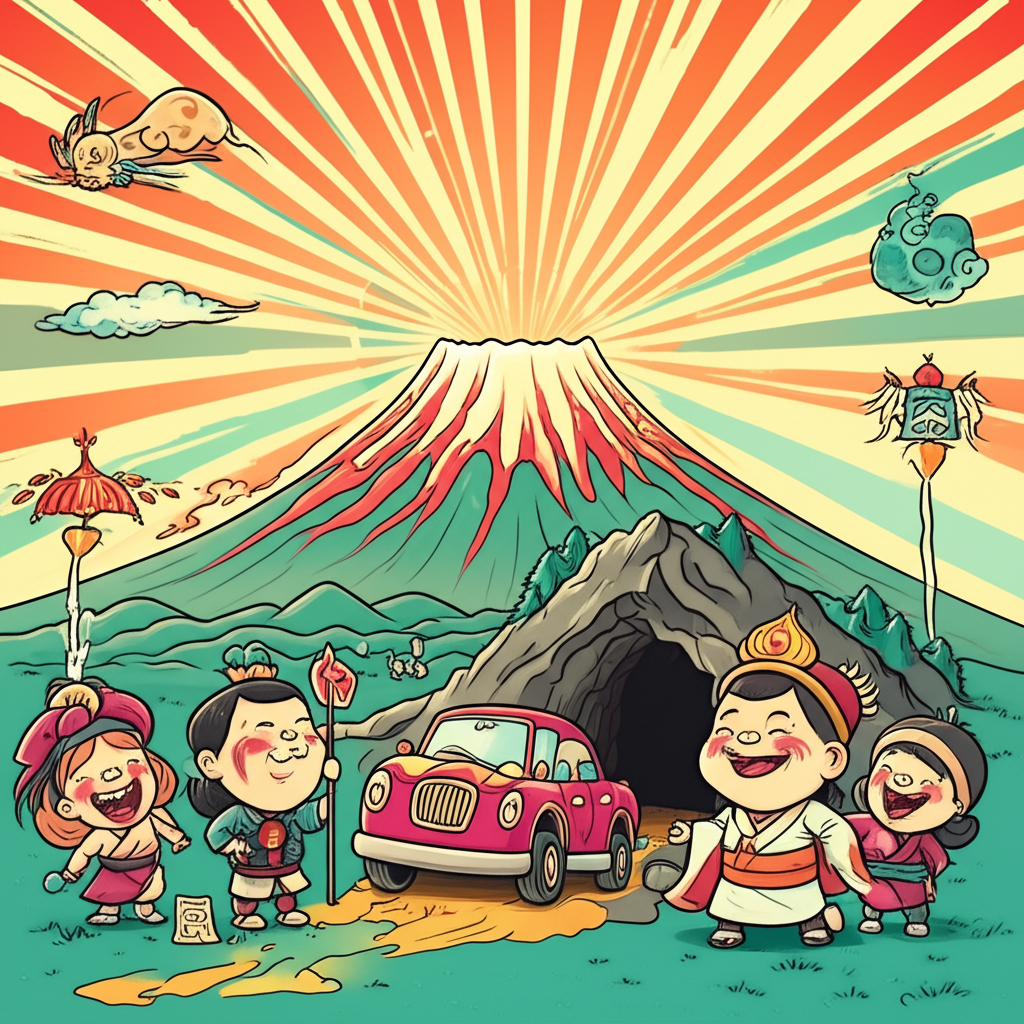
The mists clinging to the ancient peaks of Japan have long been a canvas for stories, tales woven from the threads of nature’s awe and humanity’s enduring questions. Among these narratives, one of the most resonant speaks of Amaterasu Omikami, the sun goddess, and her dramatic retreat into a cave, a myth deeply rooted in the Shinto tradition of Japan. This is not a chronicle of historical events, but rather a profound and imaginative story shared by ancient peoples to explain the cycles of the world and the relationship between the divine and the earthly.
The genesis of this legend can be traced to a time when the Japanese archipelago was a land of potent natural forces, where the sun’s warmth was life-giving, and its absence brought chilling fear. This was an era where the world was understood through the lens of kami – spirits or deities inhabiting natural phenomena. Mountains, rivers, the sun, the moon – all possessed a divine presence. The people of that time, likely living in agrarian societies, were acutely aware of the rhythms of the seasons, the vital importance of sunlight for their crops, and the profound impact of celestial events. Their worldview was animistic, seeing the sacred woven into the very fabric of existence. Myths like the tale of Amaterasu’s cave served as a way to understand these powerful forces, to imbue them with narrative, and to establish a sense of order and meaning in a world that could often feel unpredictable and formidable.
At the heart of this narrative stands Amaterasu Omikami, often depicted not as a human in form, but as the radiant embodiment of the sun itself. She is the celestial entity who brings light, warmth, and life to the world. Symbolically, Amaterasu represents illumination, clarity, and the dawn of a new day. Her power is intrinsically linked to visibility and the banishment of darkness. In the context of ancient Japanese belief, she was a central figure, a benevolent deity whose presence ensured prosperity and harmony. Her symbolic attributes are those of light: brilliance, warmth, life-giving energy, and the ultimate source of visibility. These are not attributes to be believed as literal divine power, but rather as profound metaphors for the essential role the sun played in the lives and understanding of the people who conceived this story.
The narrative of Amaterasu’s cave, often recounted as the “Ama-no-Iwato” legend, begins with a disruption. The tales describe her brother, the impetuous god Susanoo-no-Mikoto, whose wild and destructive behavior causes immense distress to Amaterasu. In her sorrow and frustration, she withdraws from the world, plunging it into an unprecedented period of darkness. Imagine the chilling silence that would fall upon a world accustomed to the sun’s golden embrace. The vibrant greens of the fields would fade, the warmth would recede, and a pervasive gloom would settle over the land. This absence of light was not merely an inconvenience; it was a profound existential crisis.
The world, now cloaked in an eternal twilight, teetered on the brink of despair. The other kami, witnessing the devastation and the fear that gripped humanity and the natural world alike, knew something had to be done. They gathered, their divine forms silhouetted against the dim sky, desperately seeking a way to coax Amaterasu from her self-imposed exile. Various attempts were made, tales of clever stratagems and mournful pleas. One of the most famous involves the goddess Uzume, whose playful and provocative dance, accompanied by the laughter of the other deities, is said to have piqued Amaterasu’s curiosity. Intrigued by the sounds of joy emanating from the darkness, she cautiously peeked out of her cave.
At this pivotal moment, a mirror was strategically placed before the cave entrance, reflecting Amaterasu’s own radiant light back at her. Astonished by her own brilliance, and perhaps by the sheer audacity of the trick, she emerged fully, the world once again bathed in her glorious luminescence. The darkness receded, the sun’s warmth returned, and life began to flourish anew. The story concludes with the kami ensuring Amaterasu would never again retreat so completely, securing the perpetual cycle of day and night.
This powerful myth carries a rich tapestry of symbolism for the ancient Japanese. The primary meaning revolves around the fundamental duality of light and darkness, and the essential nature of the sun’s life-giving force. Amaterasu’s retreat represents periods of despair, chaos, or the withdrawal of guidance and order. Her return signifies renewal, hope, and the restoration of balance. The myth also speaks to the consequences of destructive behavior and the importance of community and collaboration in overcoming adversity. The collective effort of the kami to bring Amaterasu back underscores the idea that even powerful forces can be influenced by wisdom, creativity, and unity. It can be interpreted as a metaphor for the importance of leadership and the impact of a single individual’s actions on the well-being of the entire community.
In the modern era, the tale of Amaterasu’s cave continues to resonate, albeit through a different lens. In literature and popular culture, Amaterasu is often reimagined as a powerful, divine figure in fantasy novels, manga, and anime. Her story is frequently adapted, with characters embodying her radiant power or grappling with themes of light, darkness, and exile. In cultural studies, this myth serves as a valuable window into the ancient Japanese worldview, offering insights into their understanding of cosmology, their reverence for nature, and their societal values. It is a testament to the enduring power of storytelling to convey complex ideas and to connect generations through shared narratives.
It is crucial to reiterate that the story of Amaterasu’s cave is a traditional narrative, a product of ancient imagination and cultural expression. It is not a historical account or a factual representation of reality. As Muslims, we recognize that only Allah (God) is the true Creator and Sustainer of all that exists, and that all power and authority belong to Him alone. The beauty of such ancient stories lies not in their literal truth, but in their capacity to inspire, to teach, and to preserve the rich heritage of human thought and creativity. They are echoes of a time when people looked to the stars, to the mountains, and to the cycles of nature, and sought to understand their place within a vast and wondrous universe through the art of storytelling. The tale of Amaterasu’s cave remains a vibrant thread in the intricate tapestry of Japanese cultural heritage, a reminder of the enduring power of myth to illuminate the human experience.





